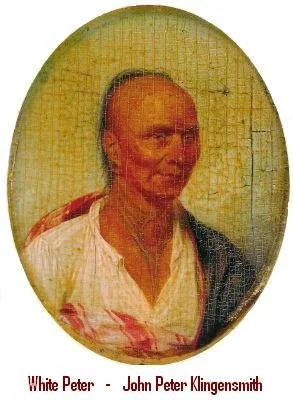Part 3. The Klingensmith Family Blockhouse Saga
More about Peter Klingensmith . . .
And the Saga Continues
with more about Peter Klingensmith . . .
Peter was brought to a Seneca village, where he was taken in by the chief’s family. They treated him like one of their own. As time passed, Peter learned the Seneca language and adopted their ways. The painful memories of his parents faded into something more like a distant, unpleasant dream. Though he had once spoken both German and English, the only language he used now was that of the Seneca.
Peter thrived in his new life. His adopted family was proud of him, and when he grew up, he married a kind and strong Seneca woman named Molly.
Oneida Warrior in Traditional dress
Years later, Peter joined the Oneida tribe—part of the Iroquois Nation—and they welcomed him not just as a member, but as a leader.
In fact, Peter became the only white man to ever serve as an Indian chief. He was called “White Peter” or “Good Peter”. The Oneida had a strong sense of justice and had been one of just two Iroquois tribes to side with the Patriots during the American Revolution.
A family living near the old Klingensmith blockhouse ended up moving to Canada, and while they were there, they crossed paths with someone unexpected—Peter. They recognized him as Peter Klingensmith, who had been taken by the Indians years earlier. Excited by the discovery, they urged him to reconnect with his brothers—and he did!
There are different versions of how Peter and his Native American wife, Molly, were received when they reunited with the surviving members of the Klingensmith family. Whatever the details, Peter and Molly eventually returned to Canada. By the time of the 1851 census, the couple and their children were listed as Indians. Still, they were active members of the Methodist Episcopal Church and lived in a modest but comfortable one-story frame house, complete with a barn and stables—a glimpse into the settled life they had built together.
Johann Peter Klingensmith, aka. “Good Peter” or White Peter
More about the Oneida Indians . . .
It was the bitter winter of 1777, and things were looking grim at Valley Forge. General Washington’s soldiers were cold, hungry, and worn down—many were on the edge of starvation. But help came from an unexpected and heroic source: Polly Cooper and Chief Shenandoah of the Oneida Nation.
Polly and Chief Shenandoah led a brave group of Oneida Indians on a long and difficult journey, traveling hundreds of miles through the snowy wilderness of New York. What did they carry with them? Seven hundred bushels of white corn—enough to make a real difference.
When they finally arrived at Valley Forge, the starving soldiers were so desperate they tried to eat the corn raw. But the Oneida knew better—raw corn would swell up in the stomach and make the men even sicker. Calm and confident, Polly stepped in and showed them exactly how to cook it safely and properly.
She didn’t stop there. Polly stayed on with the Continental Army, helping to prepare food and care for the many who were sick. Her quiet strength and generosity didn’t go unnoticed.
Statue of Polly Cooper and George Washington stands in Washington, D.C.
One day, while visiting a nearby town with some of the soldiers’ wives, Polly spotted a beautiful black shawl in a shop window. She didn’t say a word, but the ladies saw the way her eyes lit up. Touched by all she had done, they secretly gathered money—from the soldiers and their families, and maybe even from Congress, according to some stories.
Later, Martha Washington herself, along with the other ladies, presented the shawl to Polly as a gift of thanks. Polly and her family treasured it for generations, and today, it’s on loan to the Oneida Nation Cultural Center—a lasting symbol of her courage and kindness.
And Polly’s legacy lives on in more than just a shawl. At the National Museum of the American Indian in Washington, D.C., there stands a statue of Polly Cooper alongside George Washington and Chief Shenandoah—a tribute to the quiet hero who helped feed a revolution.




